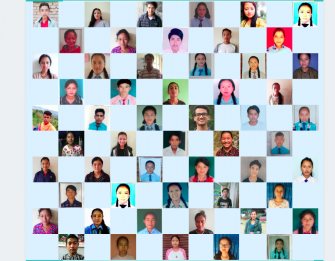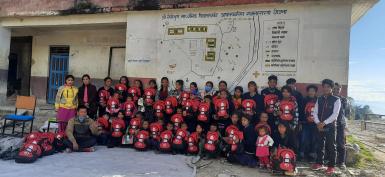Anthony Lunch Visits HELP & the Helambu Valley
By Anthony Lunch: at 2023-08-14 00:00:00
The journey from Kathmandu over the foothills to the Helambu valley offers splendid vistas of the Langtang range. But on this, our first visit since the earthquake, it was not the views that attracted our attention but the swathes of decimated houses that bordered the road. The damage done back in April 2015 was not consistent. In one village, nearly all dwellings were damaged to the point of being inhabitable. And just a mile further on, a second village seemed completely untouched. Dropping down into Helambu along the appallingly pitted and potholed mountain track, the jeep bucked like a Rodeo horse. Passengers grip hard on the seats in front, with gritted teeth much in evidence. Meeting an upcoming bus, determined to force a passage, was a challenge. With a 500ft drop to the left and a road barely more than a car’s breadth across, such encounters were perilous. Down in the Helambu valley, there were many signs of temporary dwellings. Made of plywood and corrugated iron sheets, these dotted the valley, each providing a refuge for an extended family. As we approached Melamchipul, we again encountered the desolation of broken buildings, more like a war zone than the usually tranquil valley. Whole streets were decimated, houses in ruins, stones left piled in disarray. And yet, 50 yards away, a four story office building apparently intact.
As the day wore on we gained height on our way to Tartong. Here the school had been totally destroyed and the land where it stood, so badly crevassed that the villagers had no option but to move the school to a different site a mile away. When we arrived up the twisting, turning mountain track, we found our local team of twenty builders fully engaged alongside a huge Kumit’su digger. The entire summit of the hill was being removed to make space for the classrooms and playground. An immense task compared with the normal building programmes of the past. An overnight stay was a welcome and enjoyable break after the rigours of the jeep travel. We stayed in a house built using corrugated iron sheet but still maintaining the traditional Nepali stove in the main room, its chimney rising through the ceiling. We ate Dall baht with the family, just as if nothing had happened. The people are incredibly courageous, just rebuilding their lives from nothing and getting on as before. A three hour walk next morning saw us drop 2,000 metres to the valley floor where, with aching thighs, we picked up the jeep to take us to Timbu. Here, in contrast to Tartong, we have a much easier task on our hands; clearing the bricks and debris and then laying out the foundations to build a new set of classrooms. The engineer and supervisor met us and will bring a team of builders in at the start of next week. On to Nurbuling School, one of our most successful ventures where the Primary school has been elevated to Lower Secondary with a new boarding hostel being built for girls. We inspected the site, where substantial foundations had already been put in place. The building should be up in a couple of weeks and then we can start fitting out. The spruce young teachers who had recently joined the staff made welcome speeches and we stood silently to remember the inspirational headteacher who had died in the earthquake. This school is humming and is en route to full Secondary status within a couple of years.
Finally to Nakote, where the village suffered terrible damage. Our Country Manager’s mother very nearly lost her life when her house collapsed in a pile of rubble. She had gone outside one minute earlier when she heard her cow making unexpected and alarmed noises. They say that animals feel the signs of quakes before humans. The school mainly survived but suffered serious cracks. At the request of the Department of Education, we are retrofitting wall buttresses and roof strengtheners; a big job involving a team of ten builders. At the same time, we have rebuilt the toilet block and hopefully the school will be ready for reopening by mid-April. Next day, we are off to the adjacent valley to the township where one of our largest schools is located, Gunsa. Terrible damage happened here and the house where we stayed on our last visit in 2014 was totally destroyed. Over one hundred people died here, including 30 children. Tales of extraordinary resilience emerge; the child who survived two days buried in ruins and was brought out alive and is now back at school, for example. The school is doing well. The Temporary Classrooms we built last summer are robust and should last. The main school which we built two years ago survived the worst of the earthquake but we are retrofitting classrooms so they are up to the latest specifications. Alongside them we are building eight new classrooms to the highest earthquake specs and it was good to see the foundations in place. The engineering supervisor here is a woman, quite a rarity in Nepal for senior building management. She showed us CAD versions of the new classrooms on her laptop, which seemed an amazing leap of technology for this very rural part of the Helambu region!
Two substantial schools were the target of our next visits. The first, at Gufa, took us 2,600 metres up into the highest of the foothills, where normally we would have seen Yangrima Mountain off in the midst of Langtang to the north. Sadly the visibility was poor, so we could but imagine its snowy peak! Sitting in a circle on a large swathe of grassland, the parents and teachers of the school had come to welcome us and to hold discussions about where the new buildings would be sited. These meeting are never short but they are totally democratic, so the school cleaner has an equal say to the village chairman! What was hugely impressive was the passion shown by so many of the parents, determined to show Jimmy and me how much they cared about the new buildings and the facilities they hoped we would be able to provide. Our second meeting took place a day later at Botang, right at the far northern end of the valley. After a three hour drive, we arrived late at night and slept in one of the few houses that had not suffered damage. Next morning, we visited various parts of the village and then went to the school whose 250 pupils are entirely housed in Temporary Learning Centres. We then took part in a very elaborate welcome ceremony which lasted all morning. Many scarves were hung around necks and much merriment ensued with many speeches, some singing and a bit of dancing for which we visitors can claim some responsibility! It was a happy occasion and we left fully determined to help this lovely village build its new classrooms, once we have raised the necessary funds!
The visit in Helambu ended on a high and successful note as we convened with the Loughborough University students to open Birkharka school’s first three classrooms. Built in traditional stone, but with reinforced steel added to the walls, plus additional buttresses, the classrooms were much praised for the quality of build and speed of construction by the Department of Education. I was given the honour of opening the classrooms, cutting the tape and leading the assembled dignitaries into one of the rooms to admire the workmanship. The Loughborough squad had painted the doors and windows (and themselves, it appeared!) and the whole set up looked great. An unexpected by-product of the event was the presence of a newspaper journalist who photographed the proceedings in detail. It was rather exciting next day to note that we were featured in the Himalayan Times, one of the Kathmandu dailies, and that we had beaten Prince Harry to the lead slot at the top of the page!
The Helambu visit happened to coincide with a teacher training day Jimmy had organised and I was invited to address the group. The session involved all the 20 teachers we are funding. I was impressed at the relative youth of this cohort, but also at their keenness and obvious commitment to the work they are doing. Several important topics were discussed during the day, including their relationship with the government teachers. Individual workshops took place and all the teachers had an opportunity to make presentations, and to debate the findings of their peers. It was a very successful meeting and a wonderful opportunity to meet these inspiring young people. We also saw the builder training in Kathmandu where 30 bricklayers were on a one week skill improvement course. This gives them the qualification to join our building teams in Helambu. Finally, on my last day, I was invited to give a talk to the business students at Kathmandu University. I was asked to talk about how MondoChallenge Foundation had started and how my earlier career had provided me with the skills and desire to run an international charity. It actually gave me personally food for thought, let alone the audience! It was a great finale to a fascinating fortnight.
Mondo is run in Nepal with great passion and competence by Jimmy Lama, with the support of his staff at Helambu Education & Livelihood Programme (HELP). I therefore spent quite a bit of time with the team at their new offices. Things were always busy and we had many enjoyable moments on PR matters, planning the speeches and dinner (and the wonderful cake iced to replicate our DSC Award!), discussing the important scholarship programme and ways to enhance it, and looking at project management issues with Sameer, the head of building programmes. The team are young, enthusiastic and extremely busy and Jimmy does a superb job keeping everything on track. Particularly impressive was the obvious respect and trust shown to Jimmy and his team by the Department of Education and the Village Committees. This also applied to the many large charities who have become involved in our region. Although much smaller, HELP and MondoChallenge are clearly seen as equals by even the biggest charities when it comes to the rebuilding and education programmes. Our reach is wider and knowledge deeper, and this benefits the several thousand children we support, and the fifty or more villages where we operate.
Anthony Lunch


